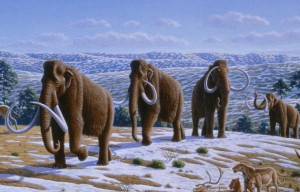Researchers were recently able to isolate and study woolly mammoth hemoglobin and compare it to the modern African and Asian elephants. They isolated the genes from DNA that code for the creation of hemoglobin, the protein that carries oxygen in our blood. This was done for both the modern elephant species, as well as from DNA from mammoth bone from Siberia. They observed some minor differences between all the species, so the researchers wondered if the difference in the mammoth’s blood might have helped it survive in cold climates.
Hemoglobin supplies our body with oxygen by carrying it around in our blood stream and then releasing it to our tissues. When our tissues need more oxygen, like for muscles that are working hard, hemoglobin more easily releases oxygen because of the higher temperatures created by the heat generated by the muscle. However, in colder temperatures, hemoglobin does not give up oxygen as easily. This is potentially a real problem in colder climates. To keep the hemoglobin to working effectively an animal might need to expend valuable energy to maintain a higher body temperature.
The researchers (Campbell et al. 2010) wondered if the slight differences in woolly mammoth hemoglobin might have been an adaptation for living in colder temperatures. They inserted the Asian elephant genes that make hemoglobin into the common bacteria, Escherichia coli, and allowed the bacteria to act on the genes, thereby making Asian elephant hemoglobin. This process is not new as it is commonly used to have bacteria produce proteins that are identical to human-made proteins, like insulin.
To get the bacteria to make mammoth hemoglobin, they needed to modify the Asian elephant genes the same way they observed, then let the bacteria make the hemoglobin of a mammoth—thousands of years after the mammoths last did it themselves. Researchers could then compare the protein of the two species directly. The result was that mammoth hemoglobin released oxygen much more effectively at lower temperatures.
Woolly mammoths were adapted to colder climates in a number of ways, such as compact bodies, small ears, short tails, and long woolly hair. This result strongly suggests that their bodies were also changed at the molecular level for life in cold, high latitude climates during the Ice Age. It would be very interesting to see if other mammoth species, such as the Columbian mammoth, for example, shared this adaptation. But I suppose that will have to wait until we can get good DNA from that species. All in good time.
Campbell, K. L. et al. 2010. Substitutions in woolly mammoth hemoglobin confer biochemical properties adaptive for cold tolerance. Nature Genetics 42:536-540.
Related posts:
Science in dinosaur movies: Jurassic Park then and now
